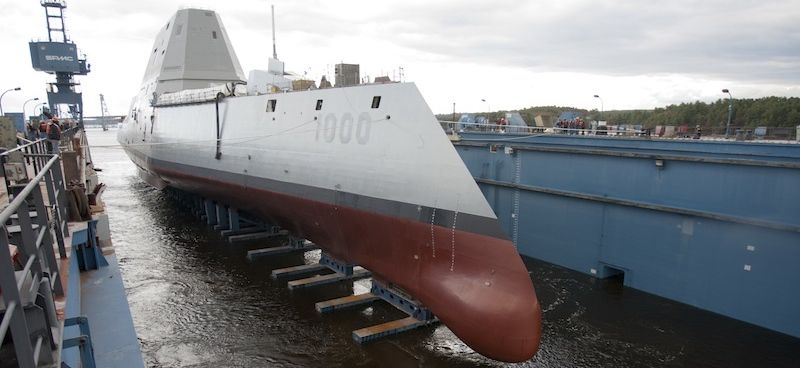
WASHINGTON: While the Navy’s modernization efforts lead the list of concerns Pentagon leadership is looking to tackle, the service’s top admiral is mapping a plan to get hypersonic missiles and lasers on ships as quickly as he can.
Adm. Mike Gilday is focused on getting hypersonic missiles on his Zumwalt destroyers first, using the long-troubled three ship class as a testbed for installing the weapon on other ships across the fleet, he said recently.
“I definitely need deeper magazines, physically deeper magazines, to be able to handle hypersonics,” Gilday told Breaking Defense. “And what I want as a testbed for that, the first surface ships that are going to have hypersonics, are going to be the Zumwalts. That’s a focus for us to field that system on the Zumwalt destroyers so that we can prove it and field it fast, and then scale it.”
The Conventional Prompt Strike round is too large to fit in the current Mk 41 vertical launching system aboard surface ships, but the Zumwalt could be fitted with larger launchers during maintenance periods, giving the three ships a mission for the first time in their troubled build and services lives.
The Navy has discussed putting the missile on Virginia-class submarines by the late 2020s initially, followed by the Zumwalt and other surface ships.
Gilday said that offensively, hypersonic missile development is his top priority, while defensively, it’s directed energy, which he called “fundamental to fleet survivability.”
“What I’m really looking for out of lasers is I need ships that can generate enough power that can support a system that can knock down missiles. And the Zumwalts have that power capacity, the Ford [aircraft carriers] have that capacity, and the DDG(X)” the service’s planned next-generation destroyer, “will have that capacity. We might be able to take a look at how we put that capacity on an unmanned vessel like that could actually be a defensive platform out there in a distributed maritime environment,” the added.
The admiral added that he’s looking to push up the schedule on the first Ford-class carrier to have it deploy next year, as opposed to the scheduled 2023 deployment date. The Ford has mostly overcome a long list of troubles with its launch and recovery systems and new radars, and has successfully been working at sea off the East Coast for much of the past year.
When it comes to a new generation of surface combatants, the 67 Arleigh Burke-class destroyers in the fleet today will have to be retired at some point, Navy officials acknowledge, with the design showing some age and the money it takes to maintain some of the oldest ships in the class could be better spent on new technologies and hulls.
“We’ve done about all we can do with this ship and we’ve maxed out the space, weight, power and cooling,” Rear Adm. Paul Schlise, head of the Navy’s Surface Warfare Division, said in January. “It’s time to reset to a new large surface combatant hull.”
Gilday work on the new fleet plans is shaped by the Chinese threat, a view that is directly in line with both the Trump and Biden administrations.
“Take a look at what China’s really investing in,” Gilday said. “Yes, they are putting more ships in the water, but they’re investing heavily in anti-ship missiles as well as satellite systems to be able to target ships. And so I’m mindful of that. And so as we make investments in closing capability gaps, that’s what makes directed energy such an important effort. It really needs to come alive so that it can be relevant against a growing threat.”
These plans come against the backdrop of a flat defense budget which looks like it may prioritize the Navy over the other services. Sources with knowledge of the Biden administration’s early planning for the 2022 budget suggest that it may only match last year’s request, marking the second year in a row that the budget will not keep up with inflation. If that goal holds up, the top line for the Pentagon’s 2022 budget would come in around the $696 billion the department received in its base funding 2021, itself just $2.6 billion more than the enacted 2020 budget.
Lawmakers on Capitol Hill appear to understand the realities of what budgets will look like in coming years.
“We’re going to deal with a much tighter budget going forward, more flat I think than rising, but within that I think we have to make judicious calls about what is worthwhile,” Sen. Jack Reed, Senate Armed Services Committee chairman, told reporters Wednesday.
“There are legacy systems, which all the services [have] asked us to eliminate, and there’s certain reluctance because they’re stationed in our home states or they have an impact. So we’ve got to look, and if there’s a tighter budget, we have to look harder,” Reed said.

